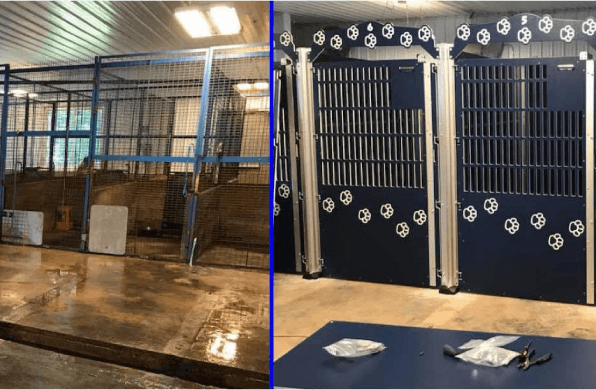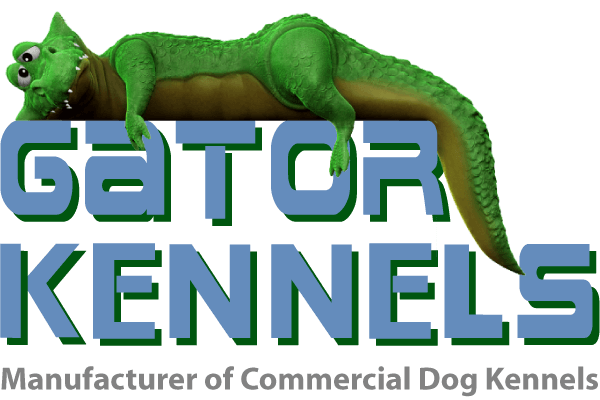The kennel slippery slope

I frequently get into discussions about floors in commercial kennels and one of the most frequent topics is on sloping the floors. There are a HUGE number of opinions about sloped floors, but today I want to explain where I stand on the slippery-slope of kennel floors.
To start off, the ONLY reason to have a sloped floor in a kennel is to help with fluids flowing in the facility. It really only makes sense to have sloped floors if you also have a drain system. Drains are a completely different topic that I will discuss at a later time. For the purpose of this blog, I will assume you want sloped floors because you also have drains.
Why you should NOT put in sloped floors in a commercial kennel facility:
- The slope makes it more difficult to assemble the kennels or other furniture.
- The slope guarantees that dogs will roll around in their urine.
- The slope actually increases the amount of cleaning you have to do.
- The slope adds a LOT of unnecessary cost.
- The slope is hard to get installed correctly.
- The slope makes it hard to make changes later.
The slope will make it MUCH more difficult to assemble the kennels or other furniture designed to sit on the floor.

The more slope, the more difficult it will be. Our kennels do have some adjustments for a floor with a slope - but more slope means more adjustments. Also, a compound slope (a slope that travels BOTH front-back AND left-right is much more difficult to work with). Some slopes are so severe that extra holes might need to be drilled in the kennel hardware to raise either the latch or hinge side of the kennel to get things to work right. We cannot engineer in every adjustment, because slopes are not always consistent throughout the facility. This means that some on-site adjustments are almost always required. Here is a quick guide on some of the most common adjustments to deal with sloped floors. We can help with suggestions or ideas of the quickest or easiest adjustments to make - so feel free to contact us if you are having troubles installing your kennel on a sloped floor.
Even if you do not have our specific kennels, nearly every style of kennel will require some form of adjustment. Also, kennels from other manufacturers tend to require extra space near walls when the floors are sloped. If you do not account for this extra space, you might not be able to fit in as many kennels as you could if the floors were flat.


The slope will GUARANTEE that when dogs urinate, they will roll around in it.
I don't know why, but dogs have a knack for urinating in the farthest up-hill corner of the kennel. This causes the urine to run down across the ENTIRE kennel area - leaving a nice slick puddle across the entire floor. Since the urine will not stop until it reaches the drain, this puddle slowly oozes across the same area the dog wants to play. Some dogs even find it fun to splash in water - so a fun moving puddle can quickly become a great place to play. Even after the dog is bored with playing, it will want to lay down eventually - and now there is an enormous puddle of urine that it cannot avoid.
The slope actually increases the amount of cleaning you have to do.
When you think about a slope running toward a drain, your first instinct might be to think this will save time. After all, the water or fluids will self-drain - right? Not usually. Similar to the scenario above, when there is water or urine on the floor, it tends to smear and spread out as it runs towards the drains. This causes the urine to cover a much larger area than it normally would otherwise. This means it will take more water or cleanser to clean that same kennel. Now, I understand that a lot of facilities like to hose out the entire kennel as part of their cleaning routine - but you want to be in complete control when the fluids are moving. For example, if you have a sloped floor going side-to side in a kennel, if you hose everything out, the water will pool along one side of the kennel. If your kennels are not completely sealed to the floor, then you will get some of this fluid seep underneath the kennel wall to the kennel next door. This means you either need to clean that kennel too - or at least clean the kennels in a specific order to avoid extra cleaning. If your kennel floor is sloped back to front, then the water can wash out the front of the kennel at inopportune times (like when another dog handler or dog is walking down the aisle). Having a flat floor and using the pressure of your water spray or a squeegee to push the water when you are truly ready is the best way to control where the water is flowing at all times. Yes, I understand it takes a little more work to move the water - but at least you are in control of when and where the water is moving.
Additionally, many drain systems cannot handle a lot of dog hair in the system. Having a sloped floor will allow more of that hair to enter the drain system - requiring more frequent maintenance and clean-up of the drains themselves. If you have a flat floor, you can push the hair to a collection-spot, pick it up, dispose of it, and continue with your cleaning so that the drains can flow freely.
The slope adds a lot of unnecessary cost.

Making a floor slope is tricky. There are a lot of things to consider; the direction of the slope, the amount of slope, how the slope interacts with the drain, how the slope interacts with the walls, what happens if there needs to be multiple slopes, etc. All of these extra complexities adds to the cost of install. Your install-person will need to know all of these answers in order to create a functionally sloped floor. Missing one of these questions could lead to really expensive repairs or replacement in the future! Sometimes special machinery might be necessary to truly get the slope created correctly. Sometimes hand-troweling the concrete when it is poured is the only way to get the slope in the floor. Not everyone can perfectly hand-trowel 30 yards of concrete into a perfect 1 degree slope. The people who can do it usually charge more for their skills. Also, sloped concrete usually has areas that need to be thicker than the minimum 4" in order to have enough strength. This can lead to higher concrete costs since you will be needing more material.
The slope is hard to get installed correctly.
There are some power trowels that are laser-leveled that can do some large sections of sloped concrete. However, there are usually areas in the kennel facility where there is a transition from a sloped-area to a flat or even a slope going the other direction. These transition areas typically require a good deal of hand-troweling to get the proper slope set. A poor job done at these transition-areas can completely undermine the rest of the work because the water will not flow as desired. Unfortunately, it is not always possible to see the problem until water starts flowing - which can be weeks or months after the floor crew is done with the job. I have seen a lot of brand-new installs need to rent floor grinders and grind down areas that were not done correctly. In some cases, this grinding cost more than the floor itself!
I have also heard horror-stories of contractors reading the blueprints wrong and putting in slopes that are FAR too big! In one instance, they misread the decimal-point - making the slope 10x bigger than it should have been! In another, they sloped the wrong direction - causing the water to run the wrong way!
Once your floors are sloped, it is hard to re-arrange or make adjustments later.
A sloped floor basically sets the way your facility needs to be laid out permanently. This can be fine if you did your homework up-front and know exactly how you want everything to work. However, if you want to add on to your facility - or if you find that you might want to re-arrange your kennels - or if you are trying to squeeze in a wash-station because you forgot to include it at the beginning, a sloped floor can really be hard to deal with later.
Your groomer is not going to like working with a wash-station or grooming table that is on a slope because the dogs will constantly be sliding and moving around.
You might have to add shims or braces underneath furniture. These shims will make the furniture level - but they will also create a gap underneath where hair, urine, and water can collect. Dog hair and water is the fastest way to rust or rot out your expensive equipment and furniture.

In Conclusion:
There is only 1 reason to add a sloped floor to your kennel facility: So you can hose out the kennels. However, I hope that I pointed out a number of the reasons to NOT add a sloped floor to your kennel facility. In our experience, they are expensive, they don't work quite as nicely as intended, and they add extra complexity to your build. Yes, you can still hose off kennels with a flat floor. In fact, the slope doesn't really hinder the movement of the washing fluids at all! More often then not, the slope causes more problems than it solves.

Thank you for reading this blog. I try to post topics that come up a lot as we discuss various projects with customers. This is part of a series of blog posts about starting your own dog daycare or boarding business.
Click here for the entire series
Also, be sure to follow us on social media and feel free to ask questions! Some of those questions might end up as the topic for our next blog post!
